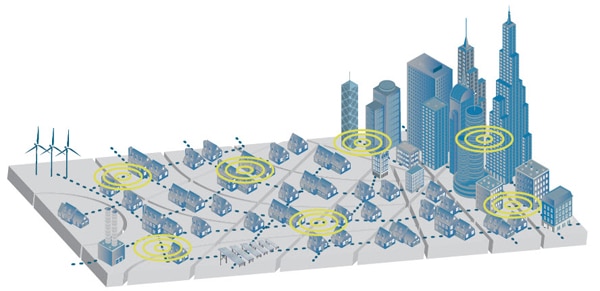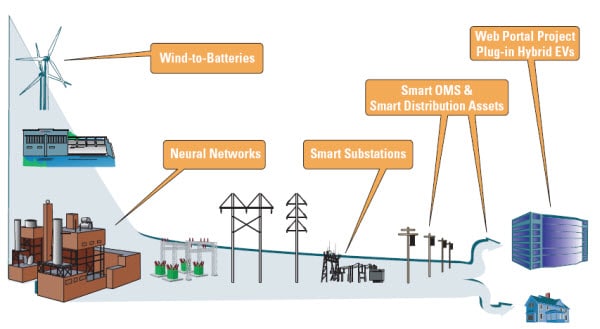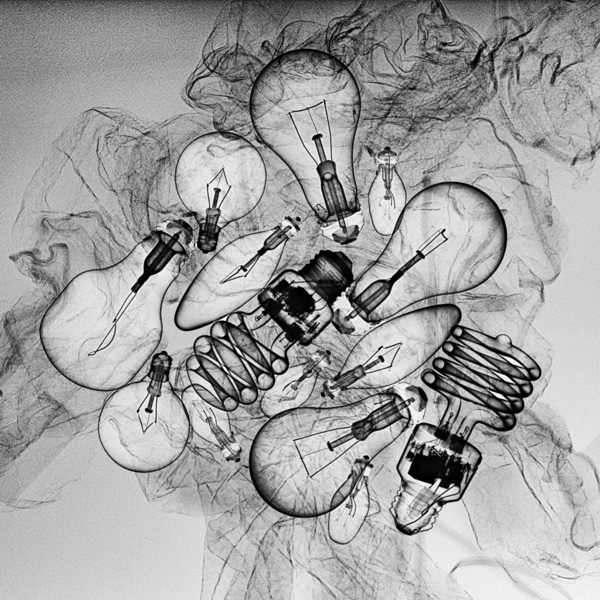I was driving back from getting coffee this morning and I heard an NPR story about how Boulder, Colorado will become the first city to have a “Smart Grid” implemented with XCel Energy. Essentially, the “experiment” will install a few thousand “smart meters” in homes in Boulder, along with dynamic technology that helps with real-time monitoring of power usage for both consumers and regulators. The Smart Grid plan also tries to integrate the plug-in hybrid vehicle technology and use the vehicle-to-grid principle – along with a few other benefits. From the XCel Energy press release:
Smart Grid City could feature a number of infrastructure upgrades and customer offerings — for the first time fully integrated through the partnership’s efforts in Boulder — including:
· Transformation of existing metering infrastructure to a robust, dynamic electric system communications network, providing real-time, high-speed, two-way communication throughout the distribution grid;
· Conversion of substations to “smart” substations capable of remote monitoring, near real-time data and optimized performance;
· At the customer’s invitation, installation of programmable in-home control devices and the necessary systems to fully automate home energy use; and
· Integration of infrastructure to support easily dispatched distributed generation technologies (such as plug-in hybrid electric vehicles with vehicle-to-grid technology; battery systems; wind turbines; and solar panels).
The potential benefits of the Smart Grid City include operational savings, customer-choice energy management, better grid reliability, greater energy efficiency and conservation options, increased use of renewable energy sources, and support for plug-in hybrid electric vehicles and intelligent-home appliances.
Writer’s note:
I think this is great on many levels, and I have questions about it on a few levels – let me get the questions out of the way first. The biggest issue I have is why did XCel Energy choose a place that is already so conscious as to its environmental footprint to implement a system that could change the way we distribute power in the United States? Doesn’t it seem like it’s almost too easy to make the results count here? One would think that implementing a system like this in a place like Detroit or maybe a south side Chicago suburb might be more of a challenge, especially in an economy like the one we find ourselves with right now. If a company like XCel Energy could challenge themselves with a project like this one (100 million bucks is the estimate I heard and read) in a lower-income and consciousness town, then going into Boulder where people already know how they impact the planet and installing a Smart Grid would be cake. This is my opinion. I also very highly respect the choice to implement this at all, period.

Another advantage of a Smart Grid system could be the monitoring and conpensation of equipment that is approaching critical failure in order to reduce down times for end users. Downtime is a pain in the butt, obviously – it can be even worse when the whole system goes down. If we had a system of devices in place that could monitor failures and perhaps even predict failures based on real-time data, a lot of outages could be made smaller in time length or magnitude.
Along with a Smart Grid system of electronics, metering, and equipment that gives us real-time information and helps us be more self-limiting on our power consumption, we need to also work on existing power infrastructure. My wife and I lived in Oklahoma City, OK for a year, and we lived through two very bad power situations in the same month – the week-long power outage due to ice and a storm that took out about 450,000 customers in OKC, and a main line failure that caused the power line to our house to explode on New Years’ Eve, 2007. The ice storm was due to power lines being taken out by trees falling onto power lines, which illustrates another issue that a Smart Grid system would need to overcome – infrastructure. Power lines out here in Colorado get buried because of these kinds of storms. If we could solve infrastructure issues at the same time that we are developing new technologies for a Smart Grid system, we could have EPIC WIN, as it were. The smart monitoring system could have helped the restoration of power in a situation like a bad ice storm as well – when we had our power restored after 5 days of outage, we were only given one of the three phases we had coming to our home, so we had a lot of dim lamps and potential for electronics failure. It just goes to show that a Smart Grid system is going to be a major overhaul of a project.
One of the best goals we can have is to have a system of goals on how to approach a Smart Grid city system of power distribution. XCel Energy has a small list in their white paper on Smart Cities on what characteristics the system could have:
An ideal location for Smart Grid City would be one that:
- Is operationally well defined and located in a geographically concentrated area (Geographic isolation is preferred; however, not required)
- Contains, or has easy access to, components necessary to implement and validate the Smart Grid concept
- Is a medium-sized metropolitan area (Approximately 50,000 customers)
- Offers “friendly” regulatory and political support
- Is visible, somewhat recognized, community (Neither obscure or remote)
- Is home to environmentally conscious consumers (Open to PHEVs, alternative sources of energy, and variations of energy usage)
- Provides optimal economic development, political, public relations and branding opportunities
- Remains open to opportunities to provide new services to the city. (Examples include: customers energy use and carbon foot print information, reliability information on specific city facilities, traffic lights, city buildings, and other high priority customers. Ability for cities to set priorities for power restoration and ability for city to see power restoration progress)
- Offers regulatory and political incentives for change (Tariffs, return, etc.)

Check out the video below for a small expose on Boulder’s Smart Grid system. Also, please post your opinions in the comments – I love your comments!
Thanks, XCel Energy, ABC News, Grist, and AutoBlogGreen!





Great! Now “Big Brother” will know when and how often I wash my underwear.
Comments are closed.